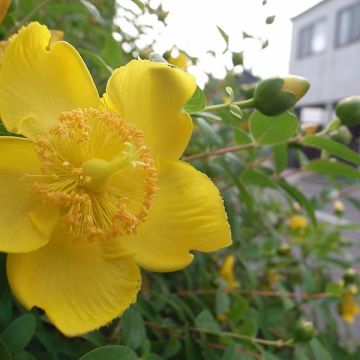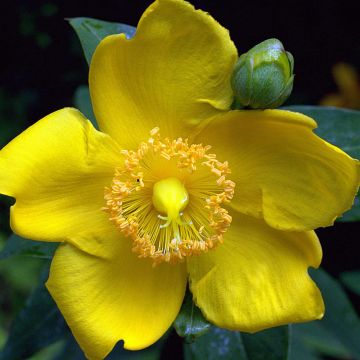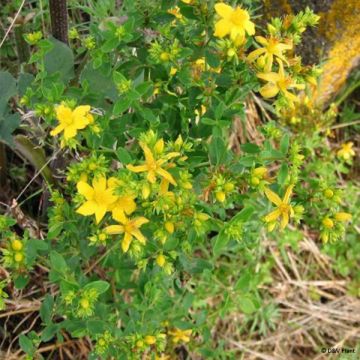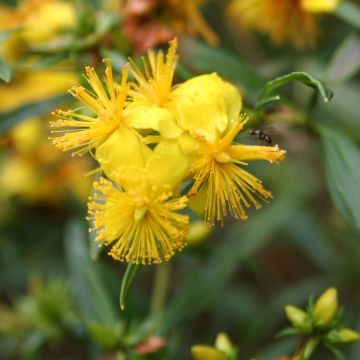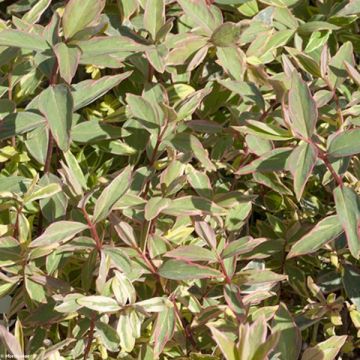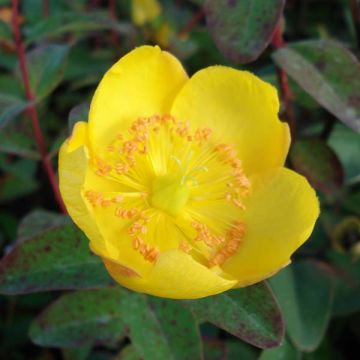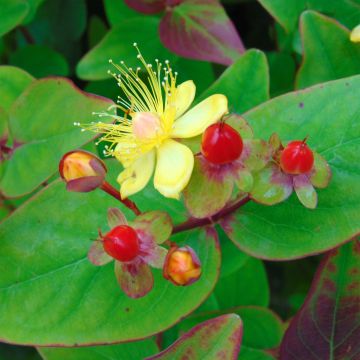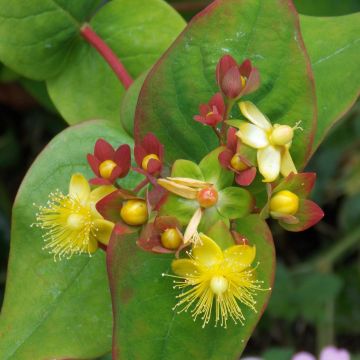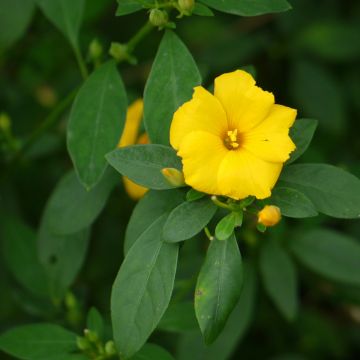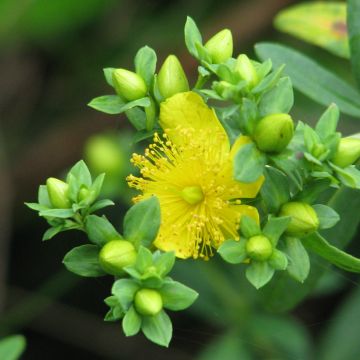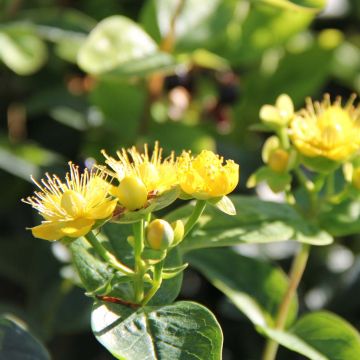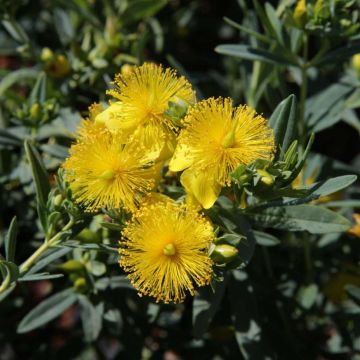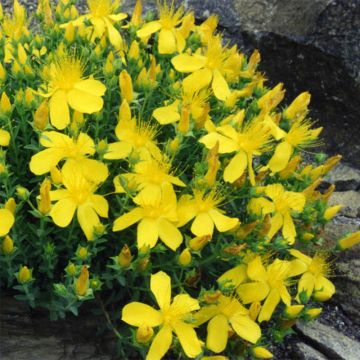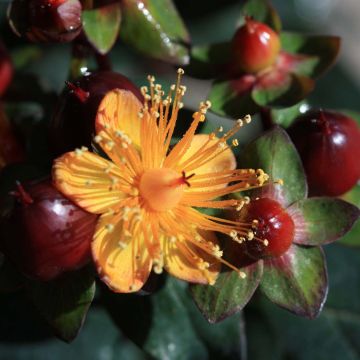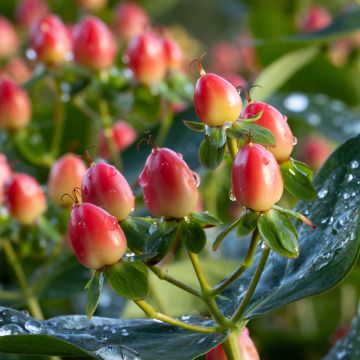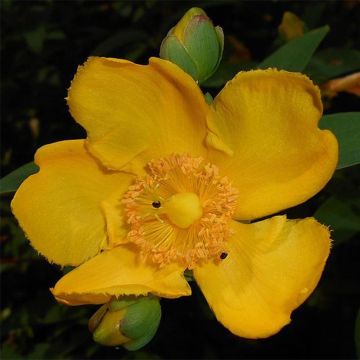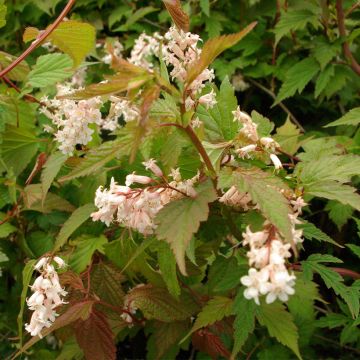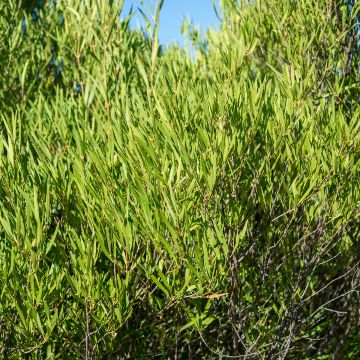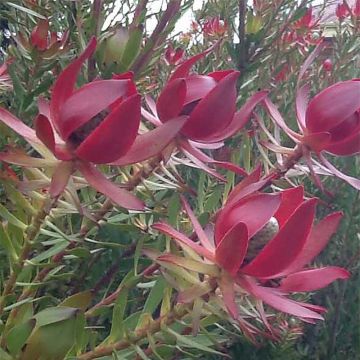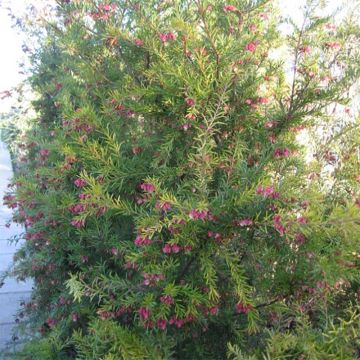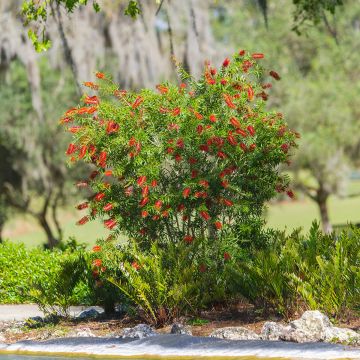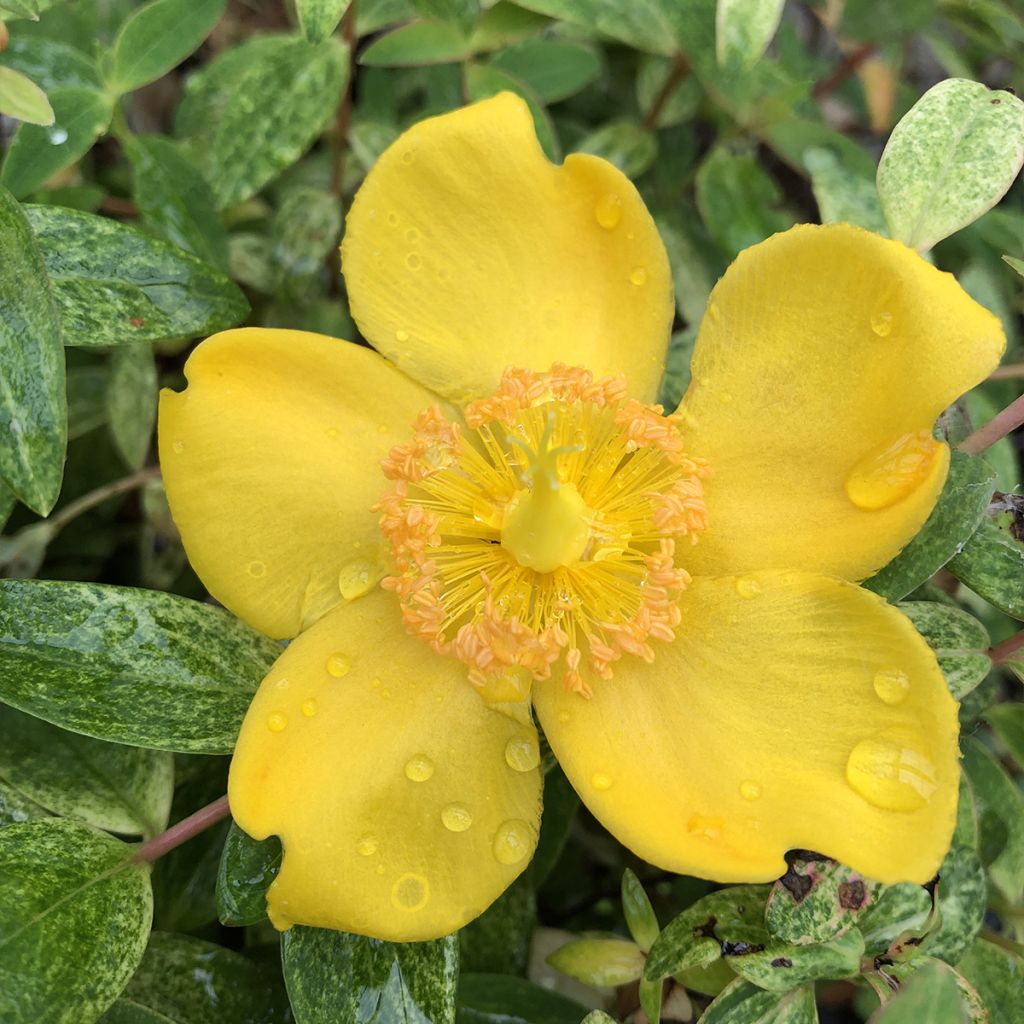

Hypericum inodorum Radiance - St. John's wort
Hypericum inodorum Radiance - St. John's wort
Hypericum Radiance® 'Marc2'
St. John's wort
Great start, this plant seems to be thriving, in the sun from midday onwards, and when paired with spruces and a pyracantha.
Eutrope, 25/11/2024
Why not try an alternative variety in stock?
View all →This plant carries a 24 months recovery warranty
More information
We guarantee the quality of our plants for a full growing cycle, and will replace at our expense any plant that fails to recover under normal climatic and planting conditions.
From €5.90 for pickup delivery and €6.90 for home delivery
Express home delivery from €8.90.
Does this plant fit my garden?
Set up your Plantfit profile →
Description
Hypericum x inodorum 'Marc02' RADIANCE® is a new variety of shrubby St. John's wort with remarkably coloured foliage, and a compact and bushy habit, perfectly suited to small spaces and container cultivation. Its young shrimp pink shoots, juvenile leaves variegated with white and green, older leaves of a deep green, and radiant yellow flowers, follow each other and blend on the plant, making this variety attractive for many months. An all-terrain plant par excellence, semi-evergreen but well hardy, it can be established everywhere, preferably in semi-shade.
Hypericum x inodorum 'Marc02' RADIANCE is a Belgian hybrid creation, whose parentage is currently unknown. Like all St. John's wort, it belongs to the Hypericaceae family. It has a fairly rapid growth rate and will generally not exceed 80cm (32in) in height and 60cm (24in) in spread. This St. John's wort has a rounded and dense habit, with well-ramified vegetation. In this variety, the young shoots and young leaves are superbly coloured and variegated with pink, white and tender green. The mature leaves are elongated ovate in shape, leathery, without petioles, of a fairly dark green, and slightly glaucous underneath. If the winter is not too harsh, they persist on the branches. This variety flowers in summer, from June to August. The flowers are compound with 5 rounded petals, golden-yellow, arranged in an open cup. The centre of the flower is occupied by a crown of protruding stamens.
St. John's wort is appreciated for its long flowering period and ease of cultivation in all soils and under all our climates, even by the sea and even in the shade. This one boasts changing foliage, which is interesting for a good part of the year. Easy to grow in ordinary but well-drained soil, it is a star plant for the terrace and the ideal small bush to install in a romantic setting, even for gardening beginners. It can be planted, for example, with purple foliage (physocarpus, berberis, bronze fennel) in a fashionable setting, or play on the perfect harmony between the yellow of its flowers and the blue of dwarf perovskia, caryopteris, nepeta, or perennial geraniums. Surround your flower beds with euphorbias and Lady's Mantle, with very flattering foliage.
Report an error about the product description
Hypericum inodorum Radiance - St. John's wort in pictures
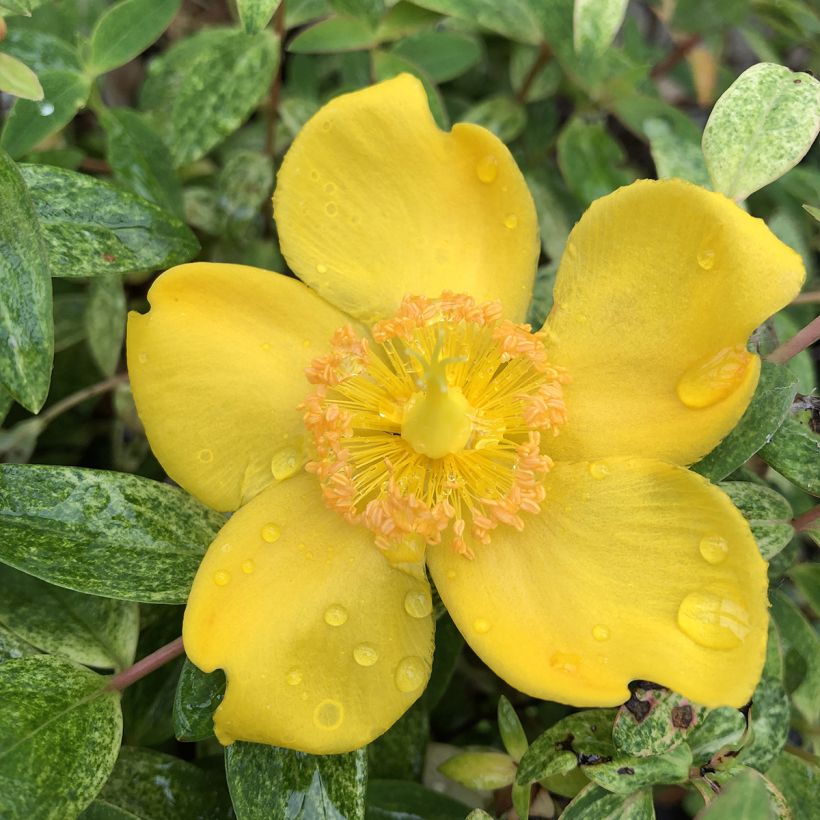

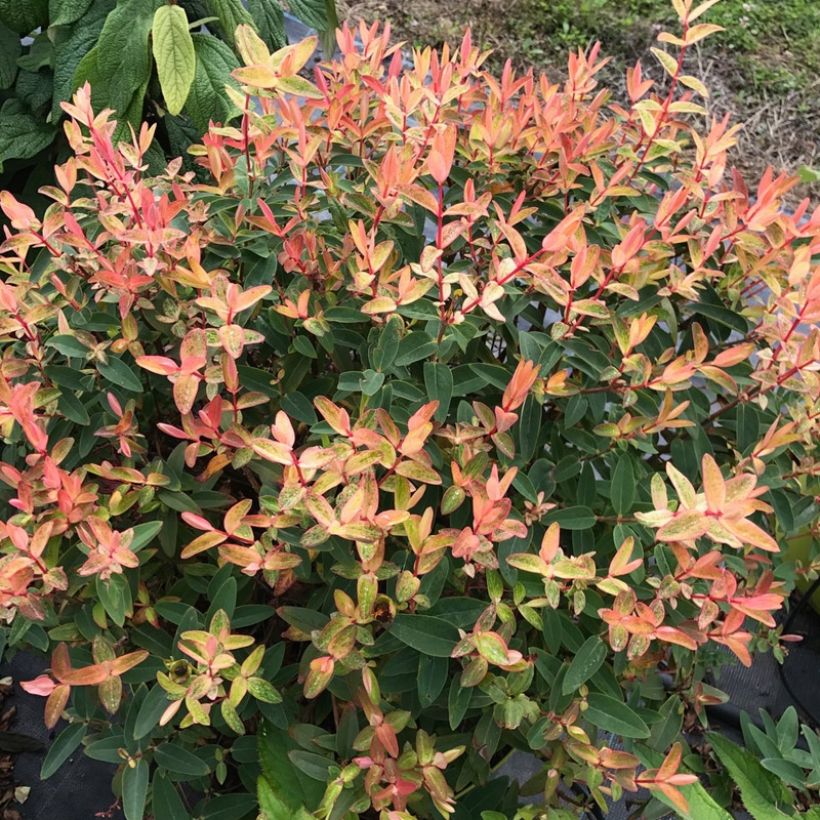

Plant habit
Flowering
Foliage
Botanical data
Hypericum
Radiance® 'Marc2'
Clusiaceae
St. John's wort
Cultivar or hybrid
Other Hypericum - St.John's Wort
Planting and care
Plant in spring or autumn, in a semi-shaded situation, sheltered from the wind. Its foliage can be damaged by too much scorching sun. This St John's wort adapts to almost all soils, as long as they are well prepared and not too compact. The pH of the soil is not important, but it should neither be excessively acidic nor excessively limey. It needs light, well-drained soil that is deep enough to better withstand dry summers. It is quite hardy, resistant to diseases, and its enemies are rare.
Perform a shaping pruning in spring to promote a compact habit.
In a pot, you will need to water it regularly and provide it with shrub fertiliser in spring and summer.
Planting period
Intended location
Care
-
, onOrder confirmed
Reply from on Promesse de fleurs
Summer-flowering shrubs
Haven't found what you were looking for?
Hardiness is the lowest winter temperature a plant can endure without suffering serious damage or even dying. However, hardiness is affected by location (a sheltered area, such as a patio), protection (winter cover) and soil type (hardiness is improved by well-drained soil).

Photo Sharing Terms & Conditions
In order to encourage gardeners to interact and share their experiences, Promesse de fleurs offers various media enabling content to be uploaded onto its Site - in particular via the ‘Photo sharing’ module.
The User agrees to refrain from:
- Posting any content that is illegal, prejudicial, insulting, racist, inciteful to hatred, revisionist, contrary to public decency, that infringes on privacy or on the privacy rights of third parties, in particular the publicity rights of persons and goods, intellectual property rights, or the right to privacy.
- Submitting content on behalf of a third party;
- Impersonate the identity of a third party and/or publish any personal information about a third party;
In general, the User undertakes to refrain from any unethical behaviour.
All Content (in particular text, comments, files, images, photos, videos, creative works, etc.), which may be subject to property or intellectual property rights, image or other private rights, shall remain the property of the User, subject to the limited rights granted by the terms of the licence granted by Promesse de fleurs as stated below. Users are at liberty to publish or not to publish such Content on the Site, notably via the ‘Photo Sharing’ facility, and accept that this Content shall be made public and freely accessible, notably on the Internet.
Users further acknowledge, undertake to have ,and guarantee that they hold all necessary rights and permissions to publish such material on the Site, in particular with regard to the legislation in force pertaining to any privacy, property, intellectual property, image, or contractual rights, or rights of any other nature. By publishing such Content on the Site, Users acknowledge accepting full liability as publishers of the Content within the meaning of the law, and grant Promesse de fleurs, free of charge, an inclusive, worldwide licence for the said Content for the entire duration of its publication, including all reproduction, representation, up/downloading, displaying, performing, transmission, and storage rights.
Users also grant permission for their name to be linked to the Content and accept that this link may not always be made available.
By engaging in posting material, Users consent to their Content becoming automatically accessible on the Internet, in particular on other sites and/or blogs and/or web pages of the Promesse de fleurs site, including in particular social pages and the Promesse de fleurs catalogue.
Users may secure the removal of entrusted content free of charge by issuing a simple request via our contact form.
The flowering period indicated on our website applies to countries and regions located in USDA zone 8 (France, the United Kingdom, Ireland, the Netherlands, etc.)
It will vary according to where you live:
- In zones 9 to 10 (Italy, Spain, Greece, etc.), flowering will occur about 2 to 4 weeks earlier.
- In zones 6 to 7 (Germany, Poland, Slovenia, and lower mountainous regions), flowering will be delayed by 2 to 3 weeks.
- In zone 5 (Central Europe, Scandinavia), blooming will be delayed by 3 to 5 weeks.
In temperate climates, pruning of spring-flowering shrubs (forsythia, spireas, etc.) should be done just after flowering.
Pruning of summer-flowering shrubs (Indian Lilac, Perovskia, etc.) can be done in winter or spring.
In cold regions as well as with frost-sensitive plants, avoid pruning too early when severe frosts may still occur.
The planting period indicated on our website applies to countries and regions located in USDA zone 8 (France, United Kingdom, Ireland, Netherlands).
It will vary according to where you live:
- In Mediterranean zones (Marseille, Madrid, Milan, etc.), autumn and winter are the best planting periods.
- In continental zones (Strasbourg, Munich, Vienna, etc.), delay planting by 2 to 3 weeks in spring and bring it forward by 2 to 4 weeks in autumn.
- In mountainous regions (the Alps, Pyrenees, Carpathians, etc.), it is best to plant in late spring (May-June) or late summer (August-September).
The harvesting period indicated on our website applies to countries and regions in USDA zone 8 (France, England, Ireland, the Netherlands).
In colder areas (Scandinavia, Poland, Austria...) fruit and vegetable harvests are likely to be delayed by 3-4 weeks.
In warmer areas (Italy, Spain, Greece, etc.), harvesting will probably take place earlier, depending on weather conditions.
The sowing periods indicated on our website apply to countries and regions within USDA Zone 8 (France, UK, Ireland, Netherlands).
In colder areas (Scandinavia, Poland, Austria...), delay any outdoor sowing by 3-4 weeks, or sow under glass.
In warmer climes (Italy, Spain, Greece, etc.), bring outdoor sowing forward by a few weeks.

































